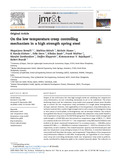Zitierlink:
http://dx.doi.org/10.25819/ubsi/10281Dateien zu dieser Ressource:
| Datei | Beschreibung | Größe | Format | |
|---|---|---|---|---|
| On_the_low_temperature_creep_controlling_mechanism.pdf | 1.51 MB | Adobe PDF |  Öffnen/Anzeigen |
| Dokumentart: | Article | Titel: | On the low temperature creep controlling mechanism in a high strength spring steel | AutorInn(en): | Institut: | Department Maschinenbau | Schlagwörter: | Martensitic steel, Low temperature creep, Exhaustion creep model, Dislocation glide, Slip localization, Strain induced phase transformation, Martensitischer Stahl, Kriechen bei niedriger Temperatur, Modell des Erschöpfungskriechens, Versetzungsgleiten, Lokalisierung von Schlupf, Dehnungsinduzierte Phasenumwandlung | DDC-Sachgruppe: | 620 Ingenieurwissenschaften und zugeordnete Tätigkeiten | GHBS-Notation: | ZLQ | Erscheinungsjahr: | 2022 | Publikationsjahr: | 2023 | Auch erschienen: | Journal of Materials Research and Technology ; 21, S. 2309–2315. - https://doi.org/10.1016/j.jmrt.2022.09.131 | Zusammenfassung: | Despite of the well-known fact that high strength steels are exhibiting low temperature creep deformation, its rate controlling mechanism is yet to be understood. The strain hardening theory and the exhaustion creep model were proposed almost seven decades ago to unravel the low temperature creep mechanism in a single phase homogeneous isotropic material. However, their applicability to low temperature creep deformation in a technical material like a modern high strength steel is still a matter of investigation owing to their nature of multi-phase, in-homogeneous, and an-isotropic behavior. The authors have grabbed this chance to experimentally validate the exhaustion creep model based on low temperature creep tests of the SAE 9254 spring steel. |
Beschreibung: | Finanziert aus dem Open-Access-Publikationsfonds der Universität Siegen für Zeitschriftenartikel |
DOI: | http://dx.doi.org/10.25819/ubsi/10281 | URN: | urn:nbn:de:hbz:467-24748 | URI: | https://dspace.ub.uni-siegen.de/handle/ubsi/2474 | Lizenz: | http://creativecommons.org/licenses/by-nc-nd/4.0/ |
| Enthalten in den Sammlungen: | Geförderte Open-Access-Publikationen |
Diese Ressource ist urheberrechtlich geschützt. |
Seitenansichten
307
checked on 12.04.2025
Download(s)
106
checked on 12.04.2025
Google ScholarTM
Prüfe
Prüfe
Diese Ressource wurde unter folgender Copyright-Bestimmung veröffentlicht: Lizenz von Creative Commons


